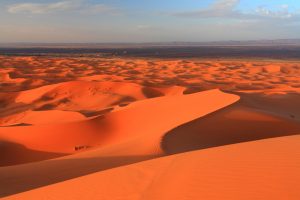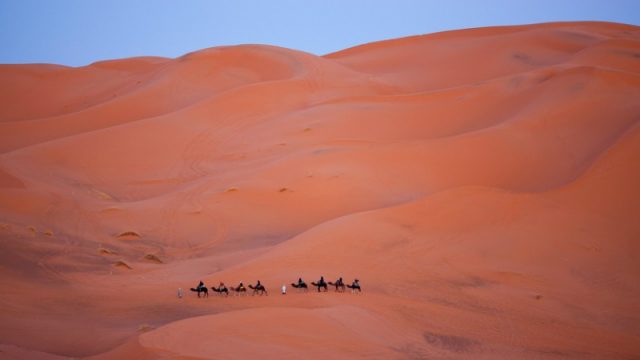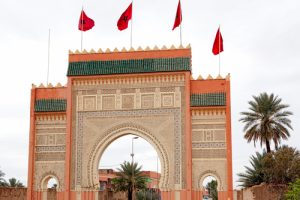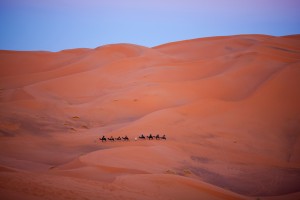If you want real adrenaline adventure in southeastern Morocco, you’ll need to venture into and beyond the wild dunes of Erg Chebbi, near the town of Merzouga.
Sandwiched between Morocco and the Algerian border lies this area that has been all but forgotten, where the Sahara lies untouched. It’s a great opportunity for adventurous off-road travel among the monstrous dunes which tower above the surrounding Hamada — the rocky, lunar surface that is so typical of the desert.

Erg Chebbi dunes, Morocco (Shutterstock)
The dunes are an amazing 50 kilometers in length and five kilometers wide, and can reach up to 350 meters in height. Sculpted into beautiful patterns by the unrelenting winds, this is desert architecture at its finest. As the sun moves across the sky, you’ll see the dunes change color, from pale cream to deep oranges and reds. Plus, at night you can have the ultimate view of the heavens, totally free from light pollution. Legend has it that the dunes were a punishment sent by God to the people of Merzouga who refused hospitality to a poor woman and her son.
Merzouga, a bustling and busy desert town of some 2,000 inhabitants, is the jumping off point for 4×4 journeys into the desert. You will definitely need a 4×4, and almost definitely a local driver. You can feel the sand, as soft as talcum powder, sucking the powerful vehicle down as you cross a waterless river, a river of soft sand. A guide and/or local driver will be able to expertly navigate this terrain, and will most likely take you east in the area along the Algerian border. The route follows the old Paris-Dakar rally trail, along a sand river (wadi) where the dunes act as a natural barrier.
The villages off the tarmac road east of the dunes including Risani and Taouz are a contrast to commercialized Merzouga. The locals here are very friendly and will invite you for tea and real desert hospitality, and are grateful for some cigarettes in return. Here nomads have been living an itinerant existence since Neolithic times, in a hostile terrain of shifting sands and rocky outcrops. Tribesmen herd their goats and camels as they have done for centuries, living with their families in camel hair tents. But their way of life is slowly being distorted by the temptations of modernity; many families have a solar panel and a battered television, and almost all have a dusty Nokia mobile phone.
But the rhythm and purpose of life is the same as it always was. To be a nomad is the pinnacle of Arabian nobility. Lest we forget, the Prophet himself was born a nomad.
If there is rain, you will see colorful plants flowering in an instant amongst the sand and rocks of the desert. There is also an abundance of animal life, such as desert foxes, fennel, jerboas, and a variety of birds, including desert sparrows and warblers (in the tamarisk trees on the fringes of the Erg Chebbi), falcons and buzzards. You may even find flamingos if rains are heavy enough to fill the Dayet Srji salt lake north west of Merzouga. There are neolithic carvings and many fossil beds. The recent discovery near Erfoud of the remains of Spinosaurus (the largest-ever dinosaur, which lived 94 million years ago) revealed that the area was once a lush jungle with deltas and lakes.
If you’re not thrilled by the idea of a 4×4 journey, there’s always a camel trek. Camels are the traditional mode of transport in the Sahara, and they move, admittedly inexorably, at a pace not dissimilar to a fit person’s walk. Saharan landscapes are as vast as the scale of the desert suggests, and travel by camel is as much a meditative experience as it is a mode of transport. In ancient times, before shipping stole their trade, camel trains journeyed back and forth from Merzouga to Timbuktu, which took around two months each way. Now the same journey can be made in two days in a 4×4.
Practical considerations: If you are travelling from Fez it takes seven hours to get to Merzouga, which is actually less time than it takes to get there from Marrakech (nine hours) because of the winding Tizi N’Tchika pass. Merzouga is also 361 km from Ouzarzate, 50 km from Erfoud and 25 km from Rissani.
A good local guide is highly recommended, but if you decide to take a self-guided trip, you’ll need to have a real sense of adventure and some pluck. If your vehicle gets stuck, which occasionally happens, you can to climb on the roof and try to call for assistance on your mobile, as the cellular networks now cover a large area. But you’ll need to be able to offer your geographical coordinates, and GPS readings in the desert area can be unreliable. If you start walking, remember that you will need a liter of water for every kilometer you walk in the hot sandy environment.




wow amazing photograph, really too good
wow amazing photograph, really too good
Thank you so much for this Article!! I can’t evoke if I already remarked on it but I’ve been sense...
Thank you so much for this Article!! I can’t evoke if I already remarked on it but I’ve been sense to. Eventually my strategy for Morocco was just to go surfing, but this entirely motivated me to go visit the desert!! And it. was. wonderful. I felt like I was on the moon as I bounded off the side of a huge dune!
http://www.viriksonmoroccoholidays.co.uk/